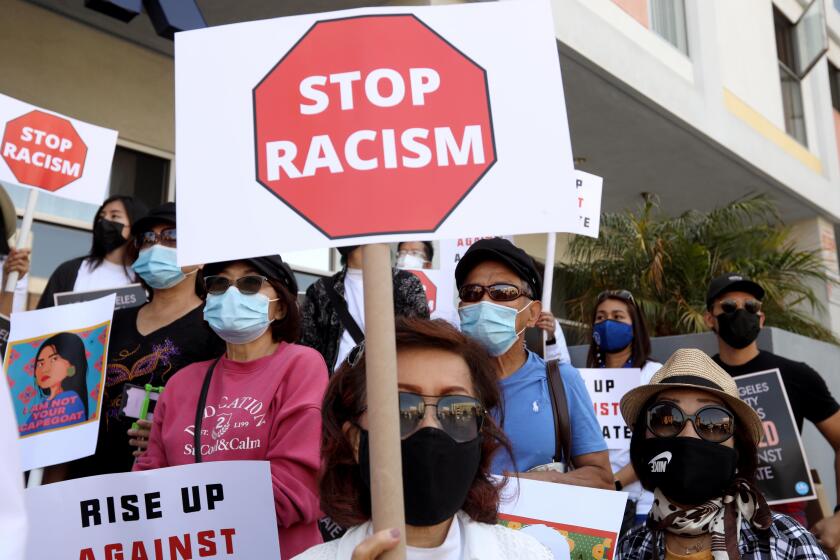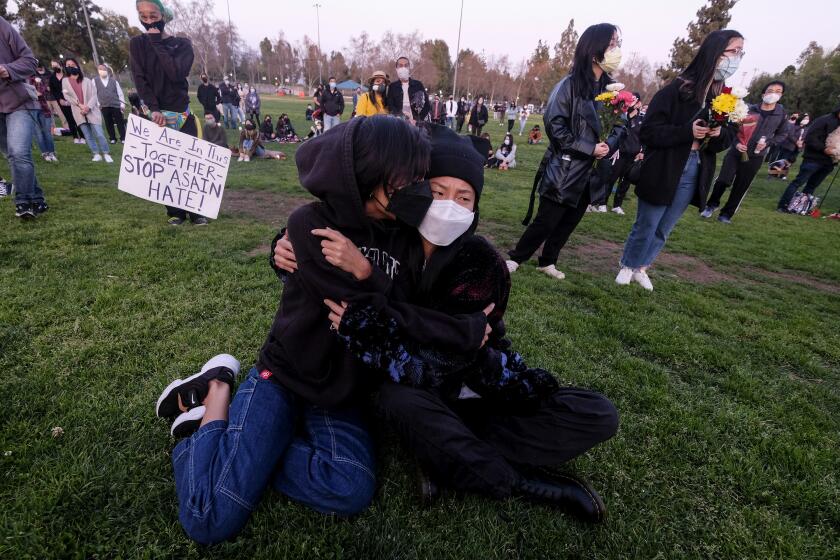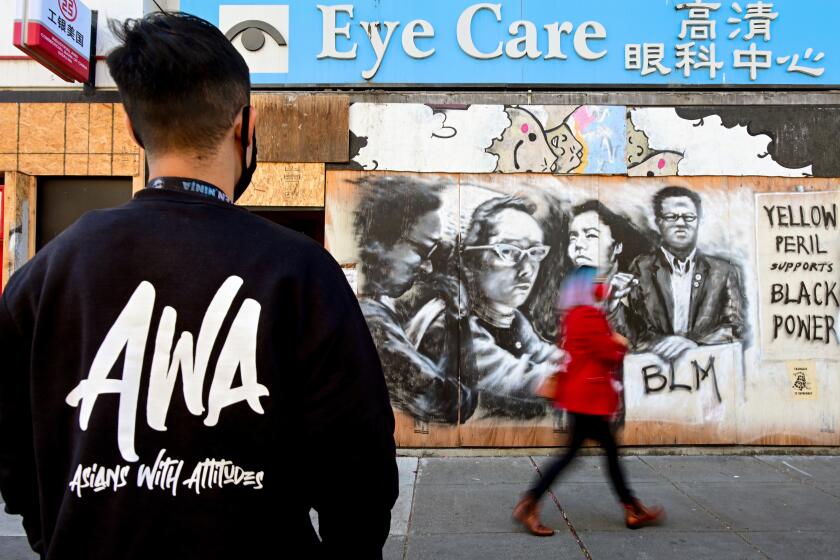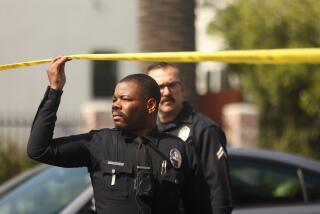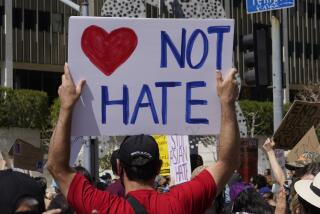Hate crimes against Asians jumped 107% in California in ‘an epidemic of hate’
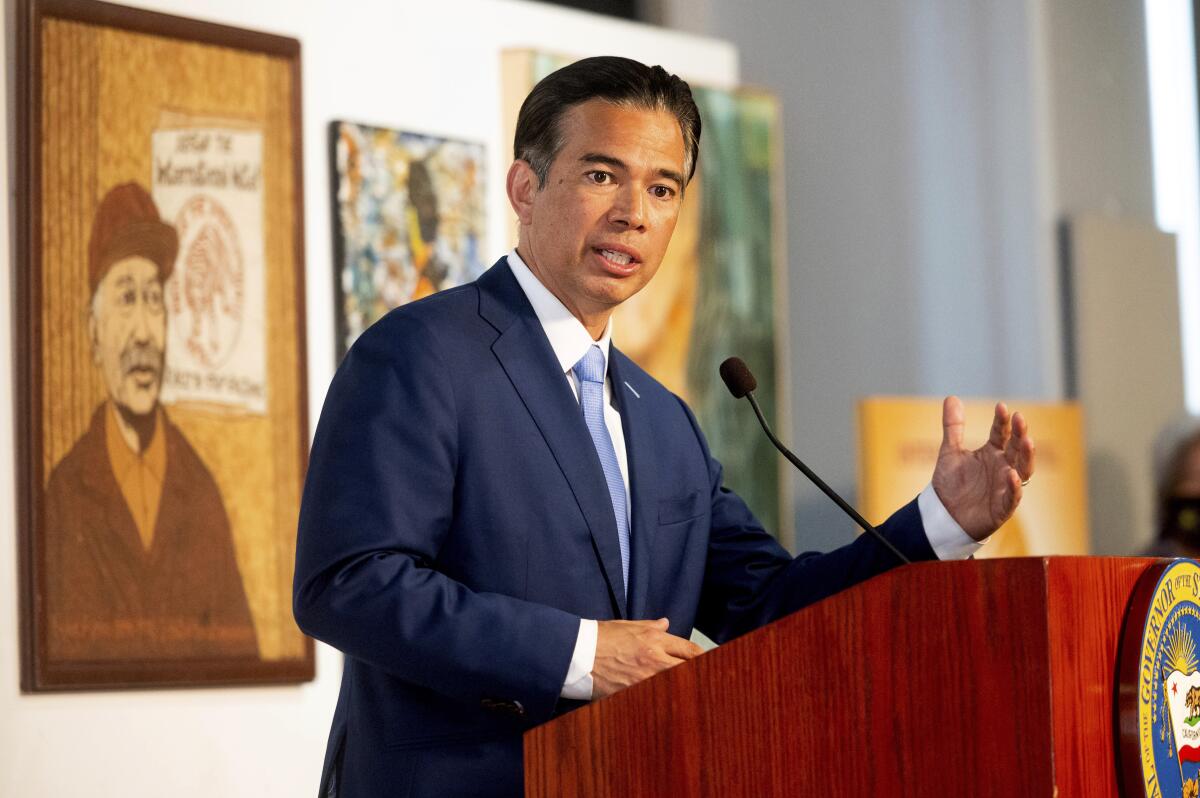
- Share via
Anti-Asian hate crimes more than doubled in California in 2020, according to a report from the state attorney general, underscoring fears among Asian Americans about being targeted during the coronavirus pandemic.
Overall, hate crimes reported to law enforcement rose 31% in the state last year, with attacks against Asians up by 107%, according to the report released Wednesday.
Hate crimes against Black people, which constituted a majority of racially motivated attacks last year, increased by 88%. Anti-Latino crimes rose 38%.
The report backs up other studies that found hate crimes rising both in California and across the country in recent years amid growing political polarization, emboldened hate groups and the stresses of a global health crisis.
The rhetoric of then-President Trump and others, blaming China for the pandemic because it originated there, has intensified anti-Asian sentiment in some quarters.
New report shows the breadth of anti-Asian racism, with attacks reported in hospitals, restaurants and schools
From brutal assaults on Asian senior citizens in Oakland and San Francisco Chinatowns to the deadly shootings of six Asian women at Atlanta-area spas, violence against Asians has assumed an unwelcome spotlight during the pandemic, even though the assailants’ motives are sometimes unclear.
“For too many, 2020 wasn’t just about a deadly virus. It was about an epidemic of hate,” said Rob Bonta, the state’s first Filipino American attorney general, at a news conference in Oakland’s Chinatown on Wednesday.
The state Department of Justice report tracked hate crimes — criminal acts motivated at least in part by characteristics such as race, gender or religion — reported to law enforcement agencies in California.
It did not monitor racist attacks that were purely verbal. Hate speech is largely protected by the 1st Amendment, becoming a hate crime only if there is a threat to a person or property.
The total number of hate crimes in the state last year, 1,330, was the highest in more than a decade. That tally includes crimes motivated by bias against religion, sexual orientation and gender, in addition to race.
Anti-white hate crimes more than doubled, from 39 in 2019 to 82 in 2020, the report found.
Anti-Jewish hate crimes fell by 18%, and anti-Muslim hate crimes also decreased last year.
Data are a powerful tool that can unearth root causes and “help cure the illness resulting from hate,” said Assemblyman Reggie Jones-Sawyer (D-Los Angeles), chair of the Assembly’s public safety committee.
Jones-Sawyer, who is Black, said the report’s finding that hate crimes against Black people rose to 456 last year from 243 the previous year was “a validation of what African Americans have been saying for centuries.”
“Until you have data, until you have images that come from body cameras to show America what has been happening, situations cannot change,” he said.
There were 89 hate crimes reported against Asian Americans in California last year, compared with 43 in 2019, the report said. In 2016, the number was 22.
One in three of the anti-Asian hate crimes occurred in Los Angeles County. Most happened at a residence or on a roadway.
In spring 2020, as stay-at-home orders prompted by the COVID-19 pandemic kicked in, anti-Asian hate crimes spiked, the report said.
There were 17 anti-Asian hate crimes in California in March 2020, compared with three the previous March.
“Asian Americans are often stereotyped as perpetual foreigners, anti-American, and carriers of infectious disease,” said an attorney general report, also released Wednesday, focusing on anti-Asian hate crimes. “These stereotypes in turn have fueled racist beliefs that Asians are responsible for introducing COVID-19 to the United States.”
Here are the stories of three Asian Americans who have dealt with racism all their lives and are now determined to speak up.
The report noted a litany of violence and discrimination against Asians throughout California’s history, from the Gold Rush of the mid-1800s to the mob attacks against Filipinos in Watsonville in 1930 to the incarceration of Japanese Americans during World War II.
The most common types of hate crimes against Asians last year were assault and intimidation, the report said.
Because a hate crime can have multiple victims, the number of victims, 101, was higher than the number of incidents.
Hate crimes are almost certainly underreported, particularly among immigrant victims who have limited English or are worried about their immigration status.
With greater education efforts and publicity about attacks, that may be changing.
The state has published brochures on identifying and reporting hate crimes in 25 languages, including Spanish, Cambodian, Chinese, Hmong, Korean, Thai and Vietnamese.
On Wednesday, Bonta, who took office in April, released guidance to law enforcement agencies and prosecutors on how to investigate and build hate crime cases.
Brian Levin, director of the Center for Study of Hate and Extremism at Cal State San Bernardino, said the guides were “first steps” for California to take a leadership role in responding to hate crimes.
“When it’s uniform, it helps ensure that cases that have important evidence will not slip through the cracks,” Levin said.
Levin led a study that examined police data from 16 jurisdictions across the country, finding a 164% increase in reports of anti-Asian hate crimes in the first quarter of 2021 compared with the same period last year.
New York saw the greatest increase, at 223%, followed by 140% in San Francisco, 80% in Los Angeles and 60% in Boston. Some cities, including Phoenix, Seattle and Miami, reported no change.
On Wednesday morning after the news conference, Bonta toured Oakland Chinatown, which he had once represented as an assemblyman, shaking hands at a central plaza with volunteers who chaperone fearful residents around the neighborhood.
Even before the Atlanta-area spa attacks that killed eight people, including six women of Asian descent, volunteer groups have sprung up to defend their Asian American communities in California.
Oakland City Councilwoman Sheng Thao said she has witnessed Asian senior citizens become “more and more uncomfortable going outside.”
“Trump stoked so much fear in our communities” and now, “they live with that fear,” said Thao, the first Hmong American elected to a city council in California.
Asian Americans should not be stereotyped as self-sufficient “model minorities,” she said. “Literally, attacks can happen at any time of the day.”
Immigrants may be reluctant to report attacks to the police because they fear being asked about their legal status, or they may lack “the right words to describe what they endured,” she said.
They may need interpreters to bring the story out in their native language.
“There’s this ‘otherness’ that many people feel because an individual community or culture is not as recognized, for example, among the Hmong or Cambodian community, compared to larger East Asian communities,” she said. “And when it’s not as recognized, it doesn’t get directed to the right social services, the right messaging to help people come forward.”
Carl Chan, president of the Oakland Chinatown Chamber of Commerce, said he had called for an increased police presence since the pandemic began.
In April, he was on his way to visit a Chinese American resident who had been attacked while riding the bus.
Someone came up from behind him and knocked him to the ground, cursing and saying, “F— you, Chinaman.” He fell, suffering scrapes and bruises and briefly blacking out.
As a community leader, he had advised others to take a photo of their attackers. He managed to do so himself, turning over the images to police, who arrested a suspect that same day, April 29.
He called on the public to “please come forward” to report more incidents.
“Don’t be afraid. Don’t just forget about it,” he said. “We have to be united.”
More to Read
Sign up for Essential California
The most important California stories and recommendations in your inbox every morning.
You may occasionally receive promotional content from the Los Angeles Times.

